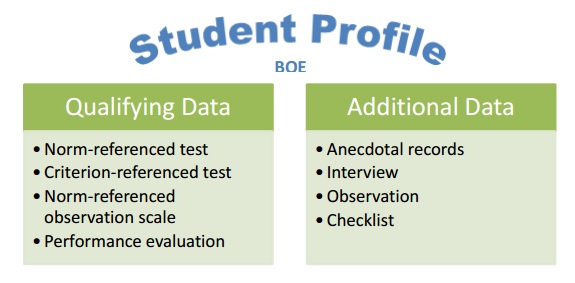Gifted Identification Considerations
Gifted Body of Evidence
Collecting a body of evidence (BOE) is a necessary step in the identification process. Data can be gathered in the following four categories: Intellectual Ability, Achievement, Behaviors/Characteristics, and Demonstrated Performance. In this short lesson, we won't make you a gifted specialist if you aren't one, but we can give you a brief overview of gifted identification in Colorado.
As a local-controlled state, Colorado districts have a choice as to what assessment tools are used in the student’s body of evidence as long as they meet state criteria.
A collection of data for a body of evidence should include assessment results from multiple sources and multiple types of data (e.g., qualitative and quantitative data about achievement, cognitive ability, performance, parent and teacher input, and observations of gifted characteristics/behaviors).
Note: Quantitative assessment data provides numerical scores or ratings that can be analyzed or quantified. Qualitative assessment data provides interpretive and descriptive information about certain attributes, characteristics, behaviors, or performances.
Gifted education specialists in districts develop seek referrals from a variety of sources used for conducting identification assessment along with universal screening in elementary and middle school. Parents are often the first identifiers of giftedness. Parental collaboration and input are essential in identifying a twice exceptional student. The complexity of identifying 2e students requires the observation, recommendations, and support of parents. While classroom teachers are in a position to provide not only academic but also social/emotional feedback, research has shown they are most likely to refer high-achieving students and not potentially struggling 2e students. It is important, therefore, to receive feedback from specials/elective teachers, support staff, and gifted education resource educators because these individuals may be in a unique position to observe strengths which might go unnoticed in the classroom setting. Students, especially at the secondary level, can provide key information regarding their strengths/talents. Providing the opportunity to self-advocate regarding their needs based on strengths is a critical element in identification.
Some examples of evidence that might be included in a robust BOE are the following:
Academic Data - For aptitude in a specific content area, normed tests are used, such as CMAS data.
Cognitive Data - Universal screeners such as CogAT or NNAT and/or individually-administered tests, such as WISC-V are used for assessment of cognitive ability.
Interviews/Questionnaires - All relevant stakeholders at the school/district as well as community members, family, and students themselves--when appropriate--should be involved.
Portfolios and Juried Performances - in the talent identification areas, a portfolio of work and performance judged by experts are used to build a body of evidence for identification purposes.
For a list of the most commonly used assessment measures, click HERE
In the BOE must be at least one piece of evidence that is nationally normed. The Rule reads: "Qualifying criteria for gifted identification which must be a part of a body of evidence for a student to be formally identified may be any of the following:
95th percentile or higher on a standardized nationally normed test
A rating on a performance assessment that indicates exceptionality/distinguished compared to age mates

Rule also states:
"Not meeting criteria on a single assessment tool shall not prevent further data collection or consideration for gifted identification, if other indicators suggest exceptional potential as observed in a body of evidence" (CO Gifted Education Guidance Document).
Identification is not just a moment in time or the use of data from one assessment.
Consider Equity When Choosing Assessments
It is also important to make sure that your tests are reliable and accessible to diverse populations of students.
These are the guiding principles for equitable and culturally responsive assessment: (Donna Y. Ford, 2005)
Every school system must be committed to equity in finding potentially gifted students.
Test bias and test fairness should be explored. Just because a test is unbiased doesn’t always mean it is fair.
Other relevant information should be taken into account if it will enhance the overall validity of the decision of the test score.
A wide range of information about the test taker should be taken into consideration on their performance, (i.e. cultural background, language, racial ethnicity, socioeconomic background).
Test scores should be used to help students, not hurt them.
- Every effort must be made to eliminate prejudice, racism, and inequities.
Once a body of evidence is collected, it must be reviewed by a team of professionals which must include at least one gifted education specialist. To identify 2e students, experts in the field recommend having professionals on the team who are trained in the ID protocols for each nominee based on the suspected area(s) of exceptionality, for example music or Language Arts, keeping in mind that some students, especially some 2e students, do not perform well on standardized tests but may show evidence of exceptional ability in other ways. Having multiple professionals able to identify exceptional ability in diverse populations and not simply relying on just test scores is necessary when working to identify 2e students, English language learners, and children from marginalized or low-income backgrounds.
"Only through a combination of formal and informal assessments can a full picture of an individual 2e student emerge" (2e Newsletter).
For more information on gifted identification in Colorado, click Here